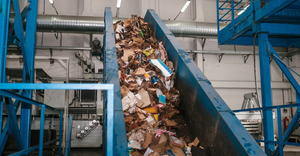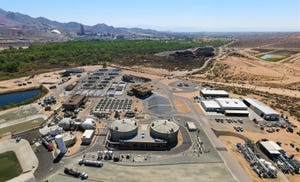Yard Waste 1130
YARD WASTE INCLUDES grass, leaves and tree and brush trimmings. By weight, grass is the biggest component of yard waste, averaging half of all yard waste. Leaves and brush each provide one quarter. By volume, leaves are the biggest component.
Yard waste is the largest single component of generated MSW by weight but is a relatively small component of landfilled MSW by volume.
The amount of yard waste and its MSW disposal market share has declined dramatically in the last four decades while the composting rate has soared. Variable rate programs have promoted backyard compost piles and grasscycling. State and local composting requirements have increased the number of commercial composting operations.
Composting is the controlled decomposition of organic matter by microorganisms into a hummus-like product. Waste and carbon dioxide dissipate into the atmosphere and up to 75 percent of volume and 50 percent of weight are lost.
Aeration, temperature control (132 F to 140 F), moisture content (40 percent) and an adequate carbon-to-nitrogen ratio are required for composting. Improper operation can cause odors and allow the growth of a hazardous fungus (asperfillus fumigatus).
Chaz Miller is state programs director for the National Solid Wastes Management Association, Washington, D.C. E-mail the author at: [email protected]
Yard Waste Municipal Solid Waste (MSW) Facts:
Generated:
28.6 million tons or 12.1 percent by weight.*
196.7 pounds per person.*
90 percent from homes, 10 percent from businesses.
Composted:
16.1 million tons or 56.3 percent.
U.S. has more than 3000 yard waste composting facilities.
Ohio leads United States in yard waste composting facilities.
Compost can be produced in as little as three months.
Incinerated or Landfilled:
12.5 million tons or 7.6 percent of discarded MSW.*
2876 Btus per pound vs. 4500-5000 Btus for a pound of garbage.
Several states have banned the burning of yard waste piles.
24 states ban or restrict yard waste disposal.
Landfill Volume:
21.7 million cubic yards (cu. yds.) or 5 percent of landfilled MSW in 1997.
Density
Uncompacted is 250-500 pounds per cubic yard.
Landfilled is 1500 pounds per cubic yard.
Source-Reduction:
Grasscycling (“leave it on the lawn” programs) and backyard composting combined to make yard waste the most source reduced item in the waste stream.
Brush can be shredded into mulch.
Xeriscaping (landscaping with plants that need small amounts of water and produce small amounts of waste) reduces yard waste.
Composting Markets:
Though not a fertilizer, yard waste compost is a useful soil conditioner that improves texture, air circulation and drainage, moderates soil temperature, enhances nutrient and water-holding capacity, decreases erosion, inhibits weed growth, and suppresses some plant pathogens.
High-quality compost is used as a soil amendment and mulch.
Can be used as daily landfill cover.
Compost processors often charge a tipping fee.
End-Market Specifications:
Vary by market.
Keep non-organic materials out.
Little heavy metal contamination.
Sources:
Biocycle, Jan. 2004, www.biocycle.com
“Municipal Solid Waste Generation, Recycling and Disposal in the United States: Facts and Figures for 2003,” U.S. EPA, Office of Solid Waste, 2005, www.epa.gov/osw
Composting Council, Amherst, Ohio www.compostingcouncil.org
Cornell Waste Management Institute, www.cfe.cornell.edu/compost
National Recycling Coalition, Measurement Standards and Reporting Guidelines, Alexandria, Va. www.nrc-recycle.org
*2003 EPA estimates.
About the Author
You May Also Like




